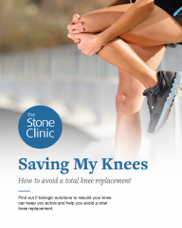Hole in Cartilage
Told you have a hole in your knee joint cartilage? Is it a divot, like in golf? Can it be fixed?

Pictured: Water polo player and osteochondritis dissecans patient George C. back to full sport after an articular cartilage paste graft procedure.
A hole in your knee is not a good thing. It generally appears in the articular cartilage: the smooth bearing surface that covers all bones in all joints. This surface is five times as slick as ice on ice and can last through a lifetime of running as long as it is not injured. When you get arthritis, that often means the articular cartilage has worn down to the underlying bone. So when you are told you have a hole in your cartilage, it is usually best to repair it—before the arthritis becomes more widespread.
Holes in cartilage can be caused by a range of sources. In young people ages 10-201,2 a disease called osteochondritis dissecans can present as a hole in the cartilage. This disease often goes unnoticed until a new injury occurs and the youth obtains an X-ray and an MRI. When painful, the hole can be patched using our articular cartilage paste graft technique. A range of other methods—such as pinning the damaged cartilage back, microfracture, or adding collagen scaffolds—have been tried, with mixed success.
Trauma can also produce holes in cartilage. Landing awkwardly from a jump, an impact from a car accident, or even a sudden hard twist of the knee can knock off a piece of the articular cartilage. Though these holes can sometimes heal on their own, most are best treated early with a cartilage-filling technique.
Another version of this problem, called post-traumatic arthritis, often occurs after a person tears another type of cartilage in their knee: the meniscus cartilage, a fibrous shock absorber that protects the articular cartilage surface. If left torn, or if a significant portion of the meniscus is removed at surgery, the weight-bearing forces of walking, running, and jumping are concentrated in a smaller area on the top of the tibia, leading to increased wear. In this case, the solution is to repair or replace the damaged meniscus before the holes occur or to repair the holes and simultaneously replace the meniscus.
The disease osteoarthritis also leads to holes in cartilage, often presenting as widespread thinning of the cartilage surface and, subsequently, exposed bone. Injections of growth factors from PRP and hyaluronic acid (the natural lubricant of the joint) can reduce the symptoms and possibly delay the progression of the arthritis. Osteoarthritis can also be treated using our paste graft technique—which is currently the only articular cartilage repair technique indicated in that disease state. We are in the middle of studies of methods to speed up that repair technique.
Holes in joints, like divots in golf courses, handicap people in all sorts of ways. Replacing the divots is polite in golf. Your joints will appreciate it, too


